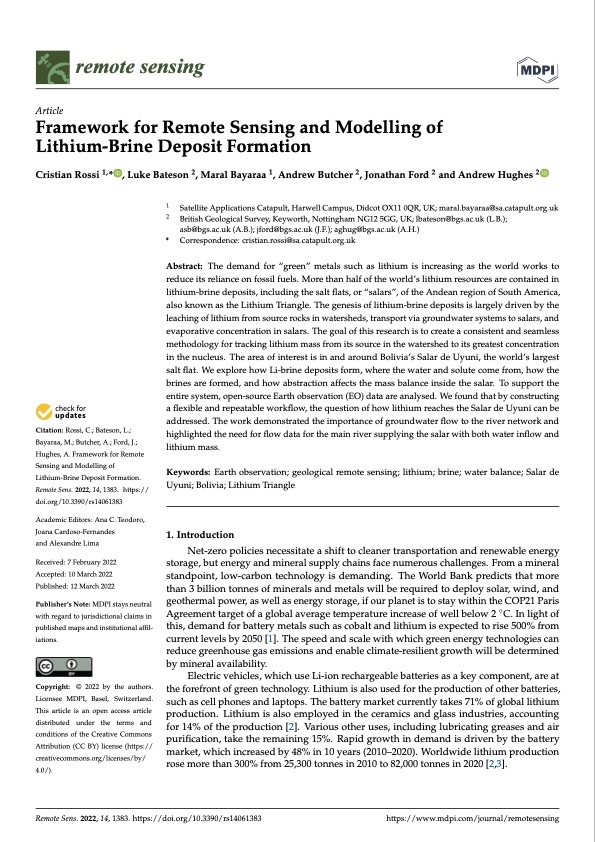
PDF Publication Title:
Text from PDF Page: 001
remote sensing Article Framework for Remote Sensing and Modelling of Lithium-Brine Deposit Formation Cristian Rossi 1,* , Luke Bateson 2, Maral Bayaraa 1, Andrew Butcher 2, Jonathan Ford 2 and Andrew Hughes 2 Citation: Rossi, C.; Bateson, L.; Bayaraa, M.; Butcher, A.; Ford, J.; Hughes, A. Framework for Remote Sensing and Modelling of Lithium-Brine Deposit Formation. RemoteSens.2022,14,1383. https:// doi.org/10.3390/rs14061383 Academic Editors: Ana C. Teodoro, Joana Cardoso-Fernandes and Alexandre Lima Received: 7 February 2022 Accepted: 10 March 2022 Published: 12 March 2022 1 2 * Correspondence: cristian.rossi@sa.catapult.org.uk Abstract: The demand for “green” metals such as lithium is increasing as the world works to reduce its reliance on fossil fuels. More than half of the world’s lithium resources are contained in lithium-brine deposits, including the salt flats, or “salars”, of the Andean region of South America, also known as the Lithium Triangle. The genesis of lithium-brine deposits is largely driven by the leaching of lithium from source rocks in watersheds, transport via groundwater systems to salars, and evaporative concentration in salars. The goal of this research is to create a consistent and seamless methodology for tracking lithium mass from its source in the watershed to its greatest concentration in the nucleus. The area of interest is in and around Bolivia’s Salar de Uyuni, the world’s largest salt flat. We explore how Li-brine deposits form, where the water and solute come from, how the brines are formed, and how abstraction affects the mass balance inside the salar. To support the entire system, open-source Earth observation (EO) data are analysed. We found that by constructing a flexible and repeatable workflow, the question of how lithium reaches the Salar de Uyuni can be addressed. The work demonstrated the importance of groundwater flow to the river network and highlighted the need for flow data for the main river supplying the salar with both water inflow and lithium mass. Keywords: Earth observation; geological remote sensing; lithium; brine; water balance; Salar de Uyuni; Bolivia; Lithium Triangle 1. Introduction Net-zero policies necessitate a shift to cleaner transportation and renewable energy storage, but energy and mineral supply chains face numerous challenges. From a mineral standpoint, low-carbon technology is demanding. The World Bank predicts that more than 3 billion tonnes of minerals and metals will be required to deploy solar, wind, and geothermal power, as well as energy storage, if our planet is to stay within the COP21 Paris Agreement target of a global average temperature increase of well below 2 ◦C. In light of this, demand for battery metals such as cobalt and lithium is expected to rise 500% from current levels by 2050 [1]. The speed and scale with which green energy technologies can reduce greenhouse gas emissions and enable climate-resilient growth will be determined by mineral availability. Electric vehicles, which use Li-ion rechargeable batteries as a key component, are at the forefront of green technology. Lithium is also used for the production of other batteries, such as cell phones and laptops. The battery market currently takes 71% of global lithium production. Lithium is also employed in the ceramics and glass industries, accounting for 14% of the production [2]. Various other uses, including lubricating greases and air purification, take the remaining 15%. Rapid growth in demand is driven by the battery market, which increased by 48% in 10 years (2010–2020). Worldwide lithium production rose more than 300% from 25,300 tonnes in 2010 to 82,000 tonnes in 2020 [2,3]. Satellite Applications Catapult, Harwell Campus, Didcot OX11 0QR, UK; maral.bayaraa@sa.catapult.org.uk British Geological Survey, Keyworth, Nottingham NG12 5GG, UK; lbateson@bgs.ac.uk (L.B.); asb@bgs.ac.uk (A.B.); jford@bgs.ac.uk (J.F.); aghug@bgs.ac.uk (A.H.) Publisher’s Note: MDPI stays neutral with regard to jurisdictional claims in published maps and institutional affil- iations. Copyright: © 2022 by the authors. Licensee MDPI, Basel, Switzerland. This article is an open access article distributed under the terms and conditions of the Creative Commons Attribution (CC BY) license (https:// creativecommons.org/licenses/by/ 4.0/). Remote Sens. 2022, 14, 1383. https://doi.org/10.3390/rs14061383 https://www.mdpi.com/journal/remotesensingPDF Image | Lithium Brine Deposit Formation

PDF Search Title:
Lithium Brine Deposit FormationOriginal File Name Searched:
remotesensing-14-01383-v2.pdfDIY PDF Search: Google It | Yahoo | Bing
Product and Development Focus for Infinity Turbine
ORC Waste Heat Turbine and ORC System Build Plans: All turbine plans are $10,000 each. This allows you to build a system and then consider licensing for production after you have completed and tested a unit.Redox Flow Battery Technology: With the advent of the new USA tax credits for producing and selling batteries ($35/kW) we are focussing on a simple flow battery using shipping containers as the modular electrolyte storage units with tax credits up to $140,000 per system. Our main focus is on the salt battery. This battery can be used for both thermal and electrical storage applications. We call it the Cogeneration Battery or Cogen Battery. One project is converting salt (brine) based water conditioners to simultaneously produce power. In addition, there are many opportunities to extract Lithium from brine (salt lakes, groundwater, and producer water).Salt water or brine are huge sources for lithium. Most of the worlds lithium is acquired from a brine source. It's even in seawater in a low concentration. Brine is also a byproduct of huge powerplants, which can now use that as an electrolyte and a huge flow battery (which allows storage at the source).We welcome any business and equipment inquiries, as well as licensing our turbines for manufacturing.| CONTACT TEL: 608-238-6001 Email: greg@infinityturbine.com | RSS | AMP |